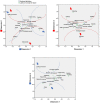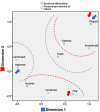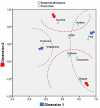Biophilia and Biophobia as Emotional Attribution to Nature in Children of 5 Years Old
- PMID: 32265804
- PMCID: PMC7099053
- DOI: 10.3389/fpsyg.2020.00511
Biophilia and Biophobia as Emotional Attribution to Nature in Children of 5 Years Old
Abstract
Introduction: Connectedness to nature is a concept that reflects the emotional relationship between the self and the natural environment, based on the theory of biophilia, the innate predisposition to the natural environment. However, the biophobic component has largely been ignored, despite, given its adaptive functional role, being an essential part of the construct. If there is a phylogenetic component underlying nature connectedness, biophilic, and/or biophobic, there should be evidence of this record from early childhood. The main aim of this study is therefore to describe the emotional attributions identified in 5 years old.
Methodology: Two studies were conducted. In the first, 94 children expressed their concept of nature and made basic emotional attributions to a set of 30 images of natural, using a software designed for the study. In the second, 39 children repeated the procedure and provided explanations for their responses.
Results: The main results show that, in general, children use both positive and negative emotions, which may be related to a three-dimensional model of emotional attributions to nature. The most widely attributed emotion is happiness. However, fear is the second most common attribution. The role of happiness could be explained by a feeling of security and familiarity, while the importance of fear in nature could show an adaptive response of the fear of wild nature in children. This interpretation could be confirmed when analyzing specifically the emotional attributions, classifying the images according to biological and ecosystemic criteria. Thus, for example, more emotional attributions are explained by the "pleasantness" attributed to primary producers and landscapes (e.g., flora), versus attributions of "harm" to the images of secondary and tertiary consumers (e.g., hunters).
Conclusion: These results provide evidence in favor of a didactic procedure to study emotional attributions to images of nature in preschool children. They suggest the incorporation of biophobia as an important adaptive factor in connectedness to nature and a tripartite emotional hypothesis based on the valences of the attributed emotions.
Keywords: biophilia; biophobia; children; connectedness; emoji; emotion; nature.
Copyright © 2020 Olivos-Jara, Segura-Fernández, Rubio-Pérez and Felipe-García.
Figures







References
-
- Ballew M. T., Omoto A. M. (2018). Absorption: how nature experiences promote awe and other positive emotions. Ecopsychology 10 26–35. 10.1089/eco.2017.0044 - DOI
-
- Barraza L. (1998). Conservación y medio ambiente para ni’os menores de 5 a’os. Especies 7 19–23.
-
- Bartos A. (2013). Children sensing place. Emot. Space Soc. 9 89–98. 10.1016/j.emospa.2013.02.008 - DOI
-
- Bomfim Z. C. (2003). Ciudad y Afectividad: Estima y Construcción de los Mapas Afectivos de Barcelona y Sao Paulo. Fortaleza: Ediciones UFC.
LinkOut - more resources
Full Text Sources

